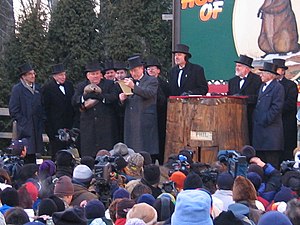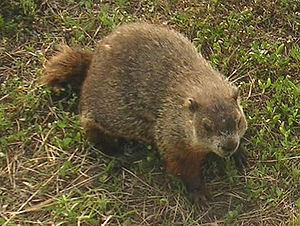 Image via Wikipedia
Image via WikipediaHow much wood could a woodchuck chuck if a woodchuck could chuck wood?
About 700 pounds. Compared to beavers, groundhogs/woodchucks are not adept at moving timber, although some will chew wood. A wildlife biologist once measured the inside volume of a typical woodchuck burrow and estimated that -- if wood filled the hole instead of dirt -- the industrious animal would have chucked about 700 pounds' worth
.
 Image via Wikipedia Image via Wikipedia |
| Woodchuck |
Celestially speaking, Groundhog Day on Feb. 2 is a "cross-quarter" day, about halfway between the winter solstice in December and the vernal equinox in March, and is celebrated in some cultures as the midpoint of winter. It's not far from the time many groundhogs end their hibernation anyway, around the second week of February.
.
.
What's going on in that burrow?
In the winter, not much. Groundhogs go into profound hibernation, greatly reducing their metabolic rate, and their body temperature drops to just a few degrees above ambient temperature. Because their hibernaculum, the deepest portion of the burrow where they hibernate, is below frost line, that produces a body temperature as low as 39-40 degrees F.
.
.
 Image via Wikipedia Image via Wikipedia |
The groundhog's internal clock is believed to be affected by annual changes in the amount of daylight. Hormonal responses to cyclic changes in production of melatonin, a sleep-related hormone, are thought by some to be the signal to wake up.
.
What's for dinner?
.
What's for dinner?
Groundhogs in the wild eat succulent green plants, such as dandelion greens, clover, plantain and grasses. They also are tempted by nearby garden vegetables. Woodchucks binge and purposefully put on weight in the summer, reaching their maximum mass in late August. They become lethargic and prepare for hibernation in October. By February, hibernating woodchucks have lost as much as half their body weight.
Sources: College of Veterinary Medicine, Cornell University; New York State Department of Environmental Conservation; Mammals of the Eastern United States, Second Edi tion, William J. Hamilton Jr. and John O. Whitaker
See also: Mammal Fact Sheets: Woodchuck

No comments:
Post a Comment